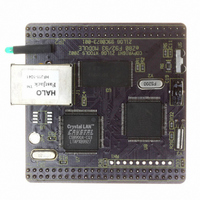EZ80F920120MOD Zilog, EZ80F920120MOD Datasheet - Page 158

EZ80F920120MOD
Manufacturer Part Number
EZ80F920120MOD
Description
MODULE EZ80F92 512K 20MHZ
Manufacturer
Zilog
Datasheets
1.EZ80F920120MOD.pdf
(269 pages)
2.EZ80F920120MOD.pdf
(4 pages)
3.EZ80F920120MOD.pdf
(2 pages)
Specifications of EZ80F920120MOD
Module/board Type
Development Module
Processor Series
EZ80F92x
Core
eZ80
Data Bus Width
8 bit
Program Memory Type
Flash
Program Memory Size
1 MB
Interface Type
Cable
Maximum Clock Frequency
20 MHz
Operating Supply Voltage
0 V to 3.3 V
Maximum Operating Temperature
+ 70 C
Mounting Style
SMD/SMT
Package / Case
LQFP
Development Tools By Supplier
eZ80F920200ZCOG
Minimum Operating Temperature
0 C
For Use With/related Products
eZ80F92
Lead Free Status / RoHS Status
Contains lead / RoHS non-compliant
Other names
269-3157
EZ80F920120MOD
EZ80F920120MOD
- Current page: 158 of 269
- Download datasheet (4Mb)
PS015308-0404
Figure 35.Clock Synchronization In I
Arbitration
A master may start a transfer only if the bus is free. Two or more masters may generate a
START condition within the minimum hold time of the START condition which results in
a defined START condition to the bus. Arbitration takes place on the SDA line, while the
SCL line is at the High level, in such a way that the master which transmits a High level,
while another master is transmitting a Low level switches off its data output stage because
the level on the bus doesn't correspond to its own level.
Arbitration can continue for many bits. Its first stage is comparison of the address bits. If
the masters are each trying to address the same device, arbitration continues with compar-
ison of the data. Because address and data information on the I
tion, no information is lost during this process. A master which loses the arbitration can
generate clock pulses until the end of the byte in which it loses the arbitration.
If a master also incorporates a slave function and it loses arbitration during the addressing
stage, it's possible that the winning master is trying to address it. The losing master must
switch over immediately to its slave-receiver mode. Figure 35 illustrates the arbitration
procedure for two masters. Of course, more may be involved (depending on how many
masters are connected to the bus). The moment there is a difference between the internal
data level of the master generating DATA 1 and the actual level on the SDA line, its data
output is switched off, which means that a High output level is then connected to the bus.
As a result, the data transfer initiated by the winning master is not affected. Because con-
trol of the I
there is no central master, nor any order of priority on the bus.
Special attention must be paid if, during a serial transfer, the arbitration procedure is still
in progress at the moment when a repeated START condition or a STOP condition is trans-
mitted to the I
must send this repeated START condition or STOP condition at the same position in the
format frame. In other words, arbitration is not allowed between:
•
CLK1 Signal
CLK2 Signal
SCL Signal
A repeated START condition and a data bit
2
C bus is decided solely on the address and data sent by competing masters,
2
C bus. If it is possible for such a situation to occur, the masters involved
State
Wait
Counter
Reset
P R E L I M I N A R Y
Start Counting
High Period
2
C Protocol
2
C bus is used for arbitra-
Product Specification
I2C Serial I/O Interface
eZ80F92/eZ80F93
146
Related parts for EZ80F920120MOD
Image
Part Number
Description
Manufacturer
Datasheet
Request
R

Part Number:
Description:
Communication Controllers, ZILOG INTELLIGENT PERIPHERAL CONTROLLER (ZIP)
Manufacturer:
Zilog, Inc.
Datasheet:

Part Number:
Description:
KIT DEV FOR Z8 ENCORE 16K TO 64K
Manufacturer:
Zilog
Datasheet:

Part Number:
Description:
KIT DEV Z8 ENCORE XP 28-PIN
Manufacturer:
Zilog
Datasheet:

Part Number:
Description:
DEV KIT FOR Z8 ENCORE 8K/4K
Manufacturer:
Zilog
Datasheet:

Part Number:
Description:
KIT DEV Z8 ENCORE XP 28-PIN
Manufacturer:
Zilog
Datasheet:

Part Number:
Description:
DEV KIT FOR Z8 ENCORE 4K TO 8K
Manufacturer:
Zilog
Datasheet:

Part Number:
Description:
CMOS Z8 microcontroller. ROM 16 Kbytes, RAM 256 bytes, speed 16 MHz, 32 lines I/O, 3.0V to 5.5V
Manufacturer:
Zilog, Inc.
Datasheet:

Part Number:
Description:
Low-cost microcontroller. 512 bytes ROM, 61 bytes RAM, 8 MHz
Manufacturer:
Zilog, Inc.
Datasheet:

Part Number:
Description:
Z8 4K OTP Microcontroller
Manufacturer:
Zilog, Inc.
Datasheet:

Part Number:
Description:
CMOS SUPER8 ROMLESS MCU
Manufacturer:
Zilog, Inc.
Datasheet:

Part Number:
Description:
SL1866 CMOSZ8 OTP Microcontroller
Manufacturer:
Zilog, Inc.
Datasheet:

Part Number:
Description:
SL1866 CMOSZ8 OTP Microcontroller
Manufacturer:
Zilog, Inc.
Datasheet:

Part Number:
Description:
OTP (KB) = 1, RAM = 125, Speed = 12, I/O = 14, 8-bit Timers = 2, Comm Interfaces Other Features = Por, LV Protect, Voltage = 4.5-5.5V
Manufacturer:
Zilog, Inc.
Datasheet:

Part Number:
Description:
Manufacturer:
Zilog, Inc.
Datasheet:










